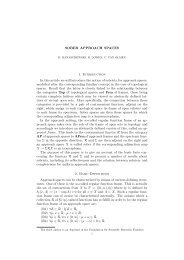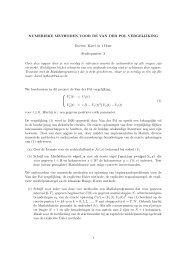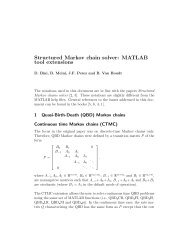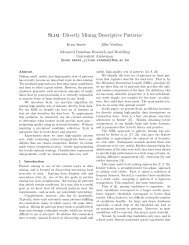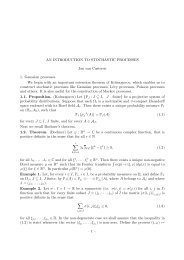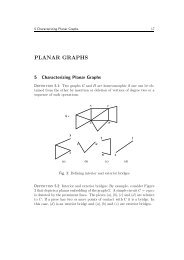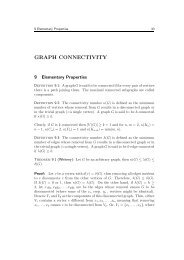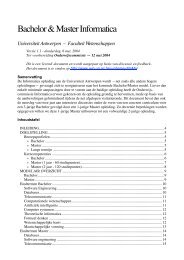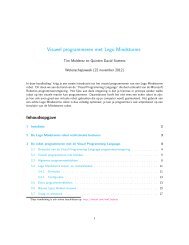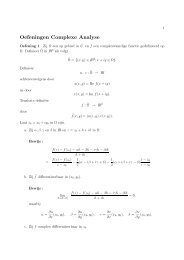Practical Rational Interpolation of Exact and Inexact Data Theory ...
Practical Rational Interpolation of Exact and Inexact Data Theory ...
Practical Rational Interpolation of Exact and Inexact Data Theory ...
You also want an ePaper? Increase the reach of your titles
YUMPU automatically turns print PDFs into web optimized ePapers that Google loves.
38 3. Interpolating continued fractions<br />
3.3 Unattainability<br />
In the description <strong>of</strong> the algorithm unattainable points are identified in<br />
step 3(b)i. However, there are possibly more unattainable points than detected<br />
by the algorithm described so far. Similarly as in the Thiele case<br />
(cf. Proposition 3.1.1), these remaining unattainable points are common<br />
zeros <strong>of</strong> the continued fraction (3.6) [Wer79]. The following Proposition<br />
characterizes these common zeros.<br />
Proposition 3.3.1. The common zeros <strong>of</strong> the numerator An ′(x) <strong>and</strong> the<br />
denominator Bn ′(x) <strong>of</strong> the n′ -th convergent <strong>of</strong> the continued fraction (3.6)<br />
constructed from Algorithm 3.2.1 are zeros <strong>of</strong> aj(x) (j = 0,... ,n ′ − 1). If<br />
xk is a zero <strong>of</strong> aj(x) for some j ∈ {0,... ,n ′ − 1} then<br />
Rj+1(xk) = 0 ⇔ An ′(xk) = 0 = Bn ′(xk)<br />
The pro<strong>of</strong> follows the one <strong>of</strong> Proposition 3.1.1 closely.<br />
Hence, including a final check to detect whether the tail Rj+1(x) vanishes<br />
at a zero <strong>of</strong> aj(x) for j = 0,... ,n ′ − 1, guarantees the detection <strong>of</strong> all<br />
unattainable points.<br />
3.4 Non-normality<br />
In order to underst<strong>and</strong> how the algorithm <strong>of</strong> Werner navigates through the<br />
table <strong>of</strong> rational interpolants, the role <strong>of</strong> the parameter rj is crucial.<br />
Werner [Wer79] imposes rj ∈ {0,1}. Since in each step ℓj ≥ mj, clearly<br />
the choice rj = 0 is always possible. Let us assume that no extra points are<br />
interpolated in step 3, so that kj = γj + 1 = ℓj − mj − rj + 1. If ℓj > mj<br />
then rj = 1 is possible. However, the choice rj = 1 then forces rj+1 = 0,<br />
because rj = 1 implies ℓj+1 − mj+1 = mj − ℓj + kj = 0. On the other h<strong>and</strong>,<br />
if ℓj = mj then necessarily rj = 0 so that kj = ℓj − mj + 1 = 1. Because<br />
now ℓj+1 − mj+1 = mj − ℓj + kj = 1, the choice rj+1 = 1 is possible. Hence<br />
subsequent values rj <strong>and</strong> rj+1 may in fact be restricted to 0 ≤ rj +rj+1 ≤ 1.<br />
This was also pointed out by Gutknecht [Gut89].<br />
The value <strong>of</strong> rj also affects the position in the table <strong>of</strong> rational interpolants<br />
<strong>of</strong> the irreducible form <strong>of</strong> the j-th convergent <strong>of</strong> the resulting continued<br />
fraction. It is not difficult to check (in analogy to Proposition 3.4.4)<br />
that with rj = 0 for all j, the irreducible form <strong>of</strong> the convergents <strong>of</strong> the continued<br />
fraction generated by Algorithm 3.2.1 occupy an entry in the table <strong>of</strong><br />
rational interpolants on the diagonal passing through (ℓ −m,0). The resulting<br />
continued fraction is appropriately called a diagonal fraction. Whenever



